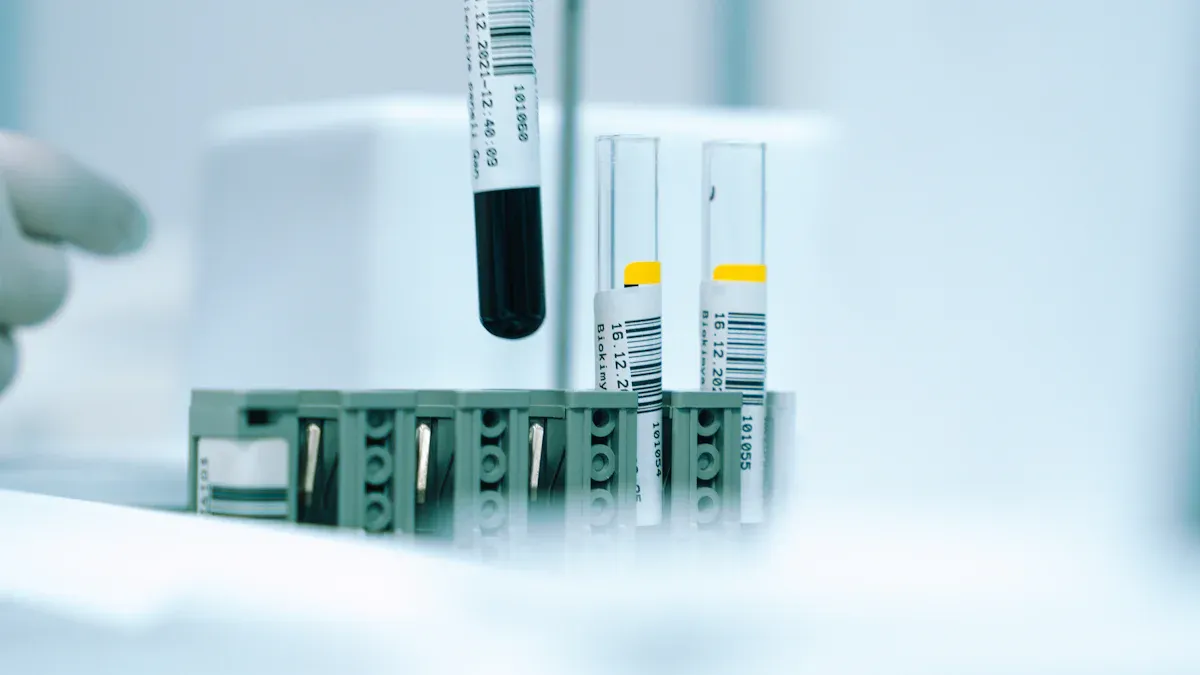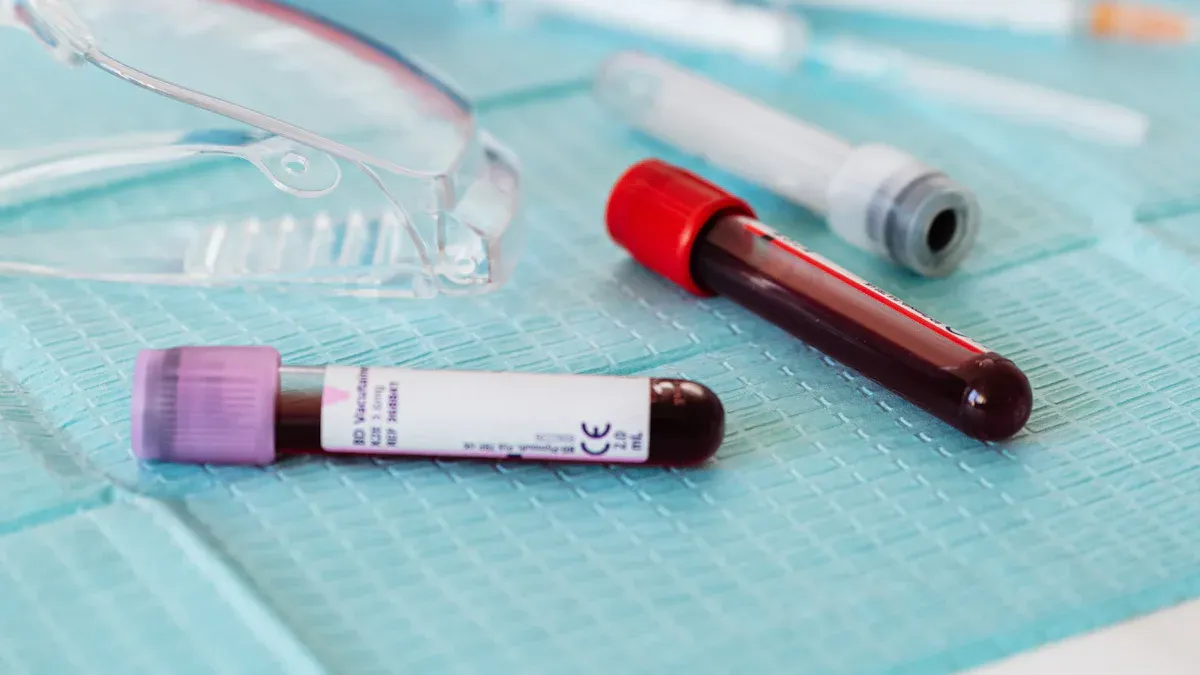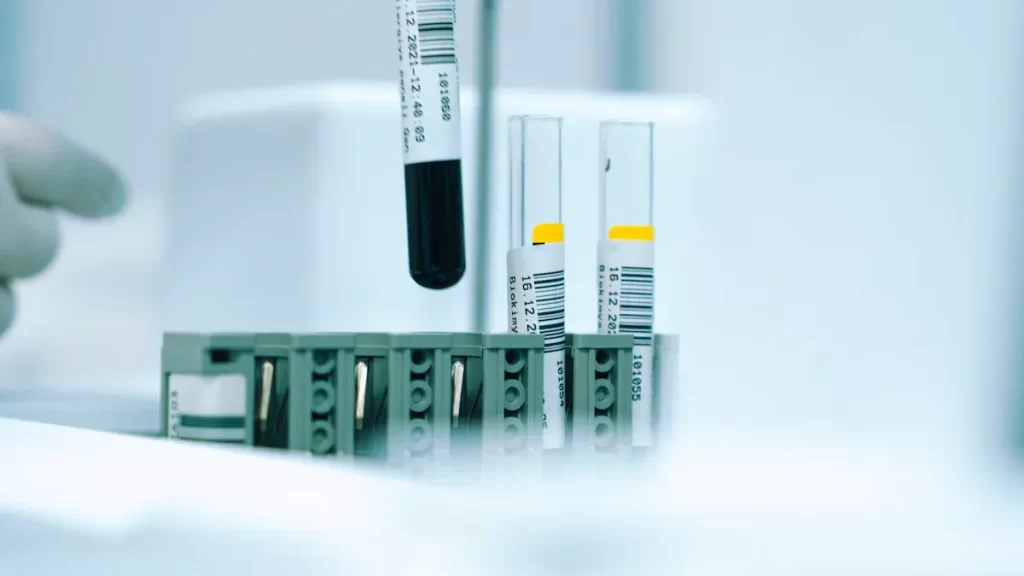News & Events
A Practical Guide to Anti-Ro SSA Antibody Testing and Interpretation

Anti-Ro SSA antibody testing helps you and your doctor find out if your immune system makes certain autoantibodies linked to autoimmune diseases. When you take this test, you check for anti-ro/ssa antibodies and anti rho antibody, both of which play a key role in diagnosis. These autoantibodies show up in up to 90% of patients with Sjögren’s syndrome and can appear before symptoms start. In the general population, about 1.7% test positive for these antibodies, but the risk rises if you have symptoms or a family history of autoimmune diseases. Testing can catch early signs, guide treatment, and prevent misdiagnosis.
Key Takeaways
- Anti-Ro SSA antibody testing helps diagnose autoimmune diseases like Sjögren’s syndrome and lupus. Early detection can lead to better management of your health.
- If you experience symptoms like dry eyes, joint pain, or fatigue, keep a record. This information can help your doctor decide if testing is necessary.
- A positive test result indicates the presence of anti-Ro SSA antibodies, which can guide your treatment plan. Regular follow-ups are essential to monitor your health.
- Understanding your antibody status can help predict potential complications, especially during pregnancy. Discuss any concerns with your healthcare provider.
- Different antibody profiles can indicate the severity of autoimmune diseases. Knowing your results helps you and your doctor make informed decisions about your care.
When to Test

Symptoms and Risk Factors
You might need an anti-Ro SSA antibody test if you notice certain signs and symptoms. Dry eyes and dry mouth are common. Some people feel joint pain, skin rashes, or unexplained fatigue. If you have a family history of autoimmune disorders, your risk increases. Women, especially those between ages 30 and 50, face a higher chance of developing autoimmune diseases. If you are pregnant and have a history of autoimmune diseases, your doctor may suggest testing. Early detection helps you and your healthcare provider manage your health better.
Tip: If you notice new or persistent symptoms, keep a record. This helps your doctor decide if testing is right for you.
Clinical Scenarios
Doctors often order this test when they suspect certain autoimmune diseases. The most common reasons include:
| Clinical Indication | Source |
|---|---|
| Diagnosis of systemic lupus erythematosus (SLE) | Anti-SSA/Ro autoantibodies |
| Diagnosis of Sjögren’s syndrome (SS) | Anti-SSA/Ro autoantibodies |
| Associated with other autoimmune diseases | Clinical and Pathological Roles of Ro/SSA Autoantibody System |
You may need this test if your doctor suspects SLE or Sjögren’s syndrome. Sometimes, doctors use the test to check for other autoimmune diseases when symptoms overlap. If you have unexplained rashes, joint pain, or other signs that do not fit one clear diagnosis, testing can help. Pregnant women with a history of autoimmune diseases may also need this test to protect their babies from possible complications.
Anti-Ro/SSA Antibodies in Autoimmune Disease
Role in Diagnosis
You may wonder how anti-ro/ssa antibodies help your doctor diagnose autoimmune disorders. These antibodies play a key role in identifying diseases like systemic lupus erythematosus and Sjögren’s syndrome. When you have certain signs and symptoms, your doctor may order tests to look for these autoantibodies. The presence of anti-ro/ssa antibodies can guide your autoimmune disorder diagnosis and help you get the right treatment.
Take a look at how often doctors find anti-ro/ssa antibodies in patients with lupus:
| Condition | Percentage of Anti-Ro SSA Antibodies Detected |
|---|---|
| Adult Systemic Lupus Erythematosus | 30-40% |
| Childhood-onset Systemic Lupus Erythematosus | 32% |
If you have Sjögren’s syndrome, the sensitivity of anti-Ro52/TRIM21 assays ranges from 48% to 79%. Anti-Ro60/SSA assays show sensitivity between 69% and 77%. These numbers mean that the tests can detect the antibody in many patients, but not all. Commercial assays often give higher sensitivity than in-house methods. Newer techniques, like the ‘sandwich’ ELISA method, improve detection rates for anti-ro/ssa antibodies.
Note: Your doctor may use several tests to diagnose autoimmune diseases. Anti-ro/ssa antibodies are just one part of the puzzle.
Overlapping Symptoms
Autoimmune diseases often share similar signs and symptoms. You might feel tired, have joint pain, or notice dry eyes and mouth. These overlapping symptoms make it hard to diagnose autoimmune disorders quickly. Anti-ro/ssa antibodies help your doctor tell the difference between conditions.
Both anti-Ro60 and anti-Ro52/TRIM21 antibodies can show up in different autoimmune diseases. If you have both antibodies, you may experience more severe symptoms. Doctors pay close attention when both are present, especially in primary Sjögren’s syndrome. Patients with both antibodies often have more serious clinical and serological features than those with only one.
- Anti-ro/ssa antibodies help your doctor diagnose autoimmune disorders with overlapping symptoms.
- The presence of these antibodies can point to specific autoimmune diseases and guide your treatment plan.
Clinical Significance
Disease Associations
You may wonder why anti-ro/ssa antibodies matter so much in medicine. These autoantibodies help you and your doctor understand the risk and presence of several autoimmune diseases. When you have a positive ana test, your doctor often checks for anti-ro/ssa antibodies to look for specific conditions. These antibodies play a key role in the diagnosis of systemic lupus erythematosus, sjögren’s syndrome, and other connective tissue disease.
You can see the clinical significance of anti-ro/ssa antibodies in many areas:
- In systemic lupus erythematosus, patients with anti-ro/ssa antibodies often show different signs and symptoms than those without these antibodies. You may experience more sicca syndrome, which means dry eyes and mouth, and you may have overlaps with other autoimmune disorders. You might notice less arthritis and need fewer strong medicines like corticosteroids. This pattern suggests that anti-ro/ssa antibodies can point to a unique type of lupus with lower disease activity.
- In sjögren’s syndrome, anti-ro/ssa antibodies are present in most patients. These antibodies help confirm the diagnosis and guide your treatment plan. If you have both Ro52 and Ro60 subtypes, you may face more severe symptoms, such as lung problems or blood cell changes.
- Anti-ro/ssa antibodies also appear in autoimmune liver diseases. For example, about 28% of people with primary biliary cirrhosis have these antibodies. This finding shows that anti-ro/ssa antibodies are not limited to connective tissue disease but also play a role in other autoimmune diseases.
- If you are pregnant and have anti-ro/ssa antibodies, your baby faces a risk of neonatal lupus erythematosus. This condition can cause congenital heart block, which affects the baby’s heart rhythm. The risk is about 2% if you have these antibodies, but if you have had a previous child with congenital heart block, the risk rises to 15%-20%.
Here is a table that shows the link between anti-ro/ssa antibodies and congenital heart block in neonatal lupus erythematosus:
| Condition | Risk Factor | Notes |
|---|---|---|
| SLE mothers with anti-SSA | 2% risk of congenital heart block | Recurrence risk 15%-20% if previously affected |
| High anti-Ro and anti-La levels | Increased cardiac complications | Especially when both antibodies are present |
| Mechanism | Disrupts heart cell electrical activity | Alters calcium balance in heart conduction system |
Note: Anti-ro/ssa antibodies are not only markers for diagnosis. They also help you and your doctor predict possible complications, especially in pregnancy.
Prognostic Value
You can use anti-ro/ssa antibodies to predict how autoimmune diseases might affect you in the future. The clinical significance of these antibodies goes beyond just finding a disease. They help you and your doctor understand the likely course and severity of your condition.
The difference between Ro52 and Ro60 subtypes matters for your prognosis. Here is a table that explains how each subtype relates to disease and outcomes:
| Subtype | Disease Association | Prognostic Implications |
|---|---|---|
| Isolated anti-Ro52 | Higher disease activity, vasculitis, pulmonary involvement | Identifies a severe subset of sjögren’s syndrome patients with increased incidence of cryoglobulinaemia |
| Dual anti-Ro52/Ro60 | Higher risk of sicca symptoms, ILD, hematologic involvement | Significantly associated with systemic complications, particularly ILD and hematologic abnormalities |
| Ro52+/Ro60+ | Elevated risk of sicca symptoms, ILD | Significantly associated with hematologic involvement |
| Ro52+/Ro60− | Increased odds of ILD | No significant association with hematologic abnormalities |
| Ro52−/Ro60+ | Not statistically significant for ILD | No significant association with systemic complications |
If you have both Ro52 and Ro60 antibodies, you face a higher risk of lung disease and blood problems. If you have only Ro52, you may have more severe sjögren’s syndrome, with a greater chance of blood vessel inflammation and lung involvement. These details help your doctor decide on the best treatment and follow-up plan for you.
Tip: Knowing your anti-ro/ssa antibody status helps you and your healthcare team watch for complications early and manage your health better.
You should remember that anti-ro/ssa antibodies are part of a larger group called antinuclear antibodies. When you have a positive ana test, your doctor uses this information along with your signs and symptoms to make a clear diagnosis. The clinical use of anti-ro/ssa antibodies in testing helps you get the right care for your connective tissue disease or other autoimmune diseases.
Anti Rho Antibody Testing
Sample Collection
When you take an anti rho antibody test, your doctor collects a sample of your blood. The quality of your blood sample affects the accuracy of your results. You need to follow specific steps to make sure your blood sample is suitable for the autoantibody test.
Here is a table that shows the best way to handle your blood sample:
| Specimen Type | Temperature | Time | Special Container |
|---|---|---|---|
| Serum | Refrigerated | 21 days | |
| Frozen | 21 days |
You should know these important points about blood collection for anti rho antibody testing:
- Specimen Type: Serum from your blood
- Preferred Collection Container: Serum gel tube
- Acceptable Collection Container: Red top tube
- Specimen Volume Required: 0.5 mL of blood
- Minimum Volume: 0.35 mL of blood
- Reject Due To: Gross hemolysis, gross lipemia, or heat-treated blood
Tip: Always make sure your blood sample is handled quickly and stored at the right temperature. This helps your doctor get the most accurate results from your anti rho antibody test.
Laboratory Methods
After your blood sample is collected, the laboratory uses special methods to find anti rho antibody. These methods help your doctor diagnose autoimmune diseases and understand your health better.
You may see these main laboratory methods for detecting anti rho antibody:
- The RNA precipitation assay gives the highest sensitivity and specificity. This method is the reference standard for anti rho antibody detection.
- Counterimmunoelectrophoresis (CIE) also provides high accuracy. It has a specificity of 100% and a sensitivity of 89%.
- ELISA is a common method in many labs. It has a specificity of 95% but a lower sensitivity of 72%.
- Immunoblot methods can also detect anti rho antibody, but their sensitivity is lower than RNA precipitation.
Your doctor chooses the best method based on your symptoms, the type of autoimmune diseases suspected, and the resources of the laboratory. Each method uses your blood to look for the antibody that signals autoimmune activity.
Note: The accuracy of your anti rho antibody test depends on both the quality of your blood sample and the laboratory method used.
Interpreting Results

Positive, Negative, Borderline
When you receive your anti-ro/ssa antibodies results, you might see three possible outcomes: positive, negative, or borderline. Each result gives you and your doctor important clues about your health.
- Positive: A positive result means your blood contains anti-ro/ssa antibodies. This finding often points to autoimmune diseases like sjögren’s syndrome or systemic lupus erythematosus. If you have symptoms such as dry eyes, dry mouth, or joint pain, a positive test can help confirm a diagnosis. Your doctor may use this information to guide your treatment and monitor your condition.
- Negative: A negative result means the test did not find anti-ro/ssa antibodies in your blood. This outcome lowers the chance that you have certain autoimmune diseases, but it does not rule them out completely. Some people with sjögren’s syndrome or lupus may still test negative, especially early in the disease.
- Borderline: Sometimes, your test result falls in a gray area. Borderline results mean the antibody level is close to the cutoff value. This can happen if you are in the early stages of an autoimmune disease or if your immune system is only mildly active. Doctors see borderline results in about 60-70% of people with sjögren syndrome and in 25% of those with systemic lupus erythematosus.
| Condition | Percentage of Cases |
|---|---|
| Sjögren syndrome | 60-70% |
| Systemic lupus erythematosus | 25% |
If you get a borderline result, your doctor may repeat the test after a few months or order other autoantibody tests. Your symptoms and medical history help guide the next steps.
Tip: Always share your symptoms and any changes in your health with your doctor. This information helps make sense of your test results.
Factors Affecting Accuracy
Several factors can affect the accuracy of your anti-ro/ssa antibodies test. You need to know these factors so you and your doctor can trust your results.
- Medications: Some medicines, such as corticosteroids and azathioprine, can change your immune system. If you take these drugs, your test results may be harder to interpret. Doctors see higher use of these medications in patients with positive ANA tests, which can affect how they read your anti-ro/ssa antibodies results.
- Comorbidities: Other health problems, like hypertension or diabetes, can also play a role. People with double-positive anti-Ro/anti-La antibodies often have fewer cases of hypertension and diabetes. This pattern suggests that these conditions may influence your test outcome.
| Factor | Description |
|---|---|
| Medications | Higher use of corticosteroids and azathioprine in patients with positive ANA, affecting test interpretation. |
| Comorbidities | Lower prevalence of hypertension and diabetes in patients with double-positive anti-Ro/anti-La antibodies, indicating potential influence on test outcomes. |
Doctors also notice that people with double-positive anti-Ro/anti-La antibodies have more joint problems but less hypertension and diabetes.
| Finding | Significance |
|---|---|
| Double-positive anti-Ro/anti-La antibodies | Associated with more frequent articular manifestations and lower prevalence of hypertension and diabetes (p=0.01). |
- Timing of Testing: The stage of your autoimmune disease can affect your results. Early in the disease, your antibody levels may be too low to detect. If your symptoms change, your doctor may suggest repeating the test.
- Sample Handling: The way your blood sample is collected and stored can impact the accuracy of your autoantibody test. Proper handling ensures the best results.
Note: Always tell your doctor about any medicines you take and any other health problems you have. This helps your doctor interpret your anti-ro/ssa antibodies results correctly.
You can see that interpreting anti-ro/ssa antibodies results takes careful thought. Your doctor looks at your test results, symptoms, and medical history to make the best diagnosis. Understanding these factors helps you take an active role in your health.
Next Steps After Testing
Follow-Up Actions
After you receive your anti-Ro SSA antibody test results, you need to take some important steps. If your test is positive, you should not ignore it. Regular check-ups help you and your doctor watch for new symptoms or changes in your health. Many people with a positive result develop autoimmune diseases or see their skin disease progress, even in a short time.
- Schedule regular evaluations with your healthcare provider.
- Watch for new symptoms, such as joint pain, dry eyes, or skin changes.
- Ask your doctor if you need early treatment with steroids or immunosuppressive medicine. Early action can lower your risk of serious problems.
- Keep a record of your symptoms and share updates at each visit.
Tip: Regular follow-up helps you catch problems early and manage your health better.
You should know that a positive autoantibody test increases your risk for certain complications. For example, people with a positive antibody have a higher chance of developing interstitial lung disease (ILD) or digital ulcers. The table below shows the risks:
| Complication | Odds Ratio (OR) | 95% Confidence Interval | P-value |
|---|---|---|---|
| ILD (anti-SSA positive) | 2.67 | 1.14–6.3 | 0.024 |
| Digital ulcer (anti-SSA positive) | 2.18 | 0.99–4.82 | 0.054 |
| ILD (anti-SSA single-positive) | 12.1 | 2.13–140.57 | 0.003 |
When to See a Specialist
You may need to see a specialist after testing, especially if you have ongoing symptoms or develop new problems. A rheumatologist can help you manage autoimmune diseases and guide your treatment plan. If you are pregnant and have a positive test, you should see a maternal-fetal medicine doctor. Babies born to mothers with persistent anti-Ro SSA antibody positivity may face growth restriction or heart problems. These children also have a higher risk of neurodevelopmental issues and autoimmune diseases later in life.
| Findings | Description |
|---|---|
| Growth Restriction | Babies with congenital heart block often have slow growth early in life. |
| Neurodevelopmental Issues | These children may have more learning or behavior problems. |
| Autoimmune Disease Risk | They have a higher chance of developing rheumatic or autoimmune diseases. |
Note: If you notice new symptoms or if you plan to become pregnant, talk to your doctor right away. Early care from a specialist can make a big difference.
Understanding anti-Ro SSA antibody testing helps you make informed choices about your health. This test plays a key role in diagnosing autoimmune diseases and guiding treatment. You can see how different antibody profiles affect disease severity and outcomes:
| Finding | Description |
|---|---|
| Dual Antibody Positivity | Linked to more severe and widespread symptoms |
| Isolated Ro60 Positivity | Often means a milder clinical course |
| Predictive Value | Helps guide treatment and predict future health changes |
- Regular check-ups with your healthcare provider support early diagnosis and better management.
- Educational resources from Rupa Health and the Sjögren’s Foundation can help you learn more.
- If you test positive, keep track of your symptoms and follow up with your doctor.
No single guideline fits every situation, so always seek advice tailored to your needs.
FAQ
What does a positive anti-Ro SSA antibody test mean?
A positive result shows that your immune system makes anti-Ro SSA antibodies. This often points to an autoimmune disease like Sjögren’s syndrome or lupus. Your doctor will use this result with your symptoms to guide your care.
Can you have anti-Ro SSA antibodies without symptoms?
Yes, you can test positive even if you feel healthy. Some people develop symptoms later. Your doctor may suggest regular check-ups to watch for any changes in your health.
Should you repeat the test if your result is borderline?
You may need to repeat the test after a few months. Borderline results can happen early in disease or with mild immune activity. Your doctor will decide based on your symptoms and history.
Do anti-Ro SSA antibodies affect pregnancy?
Yes, these antibodies can increase the risk of problems for your baby, such as heart block. If you plan to become pregnant or are pregnant, tell your doctor. You may need special care during pregnancy.
How do you prepare for an anti-Ro SSA antibody test?
You do not need to fast or change your routine. Your doctor will collect a blood sample. Make sure to tell your doctor about any medicines you take, as some can affect your results.

